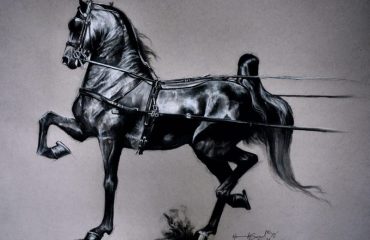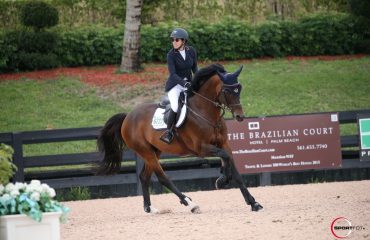By Armand Leone, Jr.
While having dinner with my family a few weeks ago, we had a conversation about the use of inflatable airbag jackets and vests while riding after recently learning of an older friend who was bucked off and severely injured. Like cycling, skiing, contact sports and cars, there have been advancements over the years in protective gear and equipment to lessen injuries in riding. Riding with an ASTM/SEI-certified helmet, competing cross-country with an ASTM/SEI-certified body protector, the use of breakaway jump cups, and removal of permanent obstacles, such as water and bank jumps, have lessened the risk of injury.
However, there is also a chance that with newer protective equipment, riders may have a false sense of security and take part in activities that exceed their competency level, therefore taking on increased risk. For example, as a rider, if I’m comfortable and confident jumping my horse 1.20m, I shouldn’t decide it’s fine to move up to 1.30m simply because I now have an added layer of protection. Our lively dinner-table discussion spanned everything from ski helmets to car airbags to protective riding vests. Little did I know I would get firsthand experience with injury the next day.
Even though I’m an older rider, I still enjoy riding, training and jumping young horses. I had set up a gymnastic with the intent to jump my 6-year-old a little higher to probe his scope and ability. After a few times through, I raised the last vertical and repeated the exercise. Unfortunately, he jumped it with one leg too low, caught the pole between his legs and he started going down. The ground was coming up quickly, so I did an “emergency dismount” with a roll to avoid hitting the ground too hard and to allow me to move away from where the horse might fall. This instinct to preserve myself during an involuntary dismount was learned over the years starting with falling off ponies and later to avoid getting hung up in big combinations. I’m glad that the reaction was still in me. Although I avoided serious injury, I cracked a few ribs and had the wind knocked out of me.
As I was looking at the ground on my hands and knees, catching my breath, I couldn’t help but think about our protective vest discussion the night before. I know that in the eventing discipline, cross-country athletes riding at recognized competitions must wear an ASTM/SEI-approved body protector — a vest made of lightweight foam intended to reduce rib fractures and penetrating injuries to the torso. While the hunter-jumper world does not carry a similar mandate, there has been increased conversation around equipment that will protect against crush-related injuries, namely airbag jackets and vests, and rightfully so. It has now been a month or so since my fall, and though I’m riding and jumping again, I bought an airbag vest. Now the question is, when will I use it?
Know Your Limitations and Evaluate the Risks
Each person has a different health and risk profile. The same fall occurring to a 25-year-old may have a very different outcome for a 60-year-old. A difficult horse being ridden by a rider with 30 years’ experience carries different risks than that horse being ridden by a rider with only three years’ experience. A gallop across a hunting field over banks and solid fences carries a different risk than jumping on a level all-weather surface with breakaway cups. How much safety gear, beyond the certified helmet and good equipment, a rider should use depends on each rider’s ability and risk preferences, along with the horse’s character and familiarity with the questions being asked by the rider.
There is ongoing research about the effectiveness of airbag jackets and vests specifically, because it stands to reason that in a serious fall, they may provide significant protection from injuries, including possibly reducing crush injuries during a rotational fall. That being said, a protective vest is not a substitute for recognizing your or your horse’s limitations, and using a protective jacket or vest should not provide riders with a sense of security that allows them to exceed their abilities. A protective jacket or vest does not make a better rider, just like a ski helmet does not make a better skier.
On the other hand, some riding situations are known to have higher inherent risk – riding a 3-year-old, training over permanent obstacles, and testing a horse’s ability are all examples of situations that will have inherently higher risks. Sometimes, the horse just makes a mistake; a 3-year-old that rears and flips over, a horse that chests a bank, or a horse that misjudges the height of a top rail. Even the best rider cannot keep a horse on its feet all of the time. In higher-risk situations, a protective jacket or vest clearly provides some added safety. So, the use of a protective jacket or vest should not be an all-or-nothing proposition. It depends on the specific situation at hand.
The Role of Protective Vests in Our Future
Should inflatable protective jackets and vests be considered mandatory equipment for competition like riding helmets are? Protective jackets and vests are an investment that can cost anywhere from $300 to upwards of $700. These pieces of equipment are an additional layer of clothing that can be bulky or hot to wear. The jackets and vests can provide protection against injuries, but it’s not a given, of course. At this point in time, which riders wear protective jackets and vests at which times and in which situations should be determined by individual riders and, if juniors, by the parent(s) or guardian(s).
Safety studies of protective equipment and improvements in equipment design should continue to lessen the inherent risk of injury from a fall in equestrian sport. USHJA has pledged $100,000 to sponsor a new helmet study. Similar studies should be performed with protective jackets and vests, specifically those with airbag technology. With more data, better decisions can be made as to who should wear them and when.
Reduced cost and improved wearability are also essential developments for wider adoption and use. The benefits of using protective jackets and vests should be made known, because as studies begin to show benefits, and as manufacturers reduce the cost and offer more comfortable designs, we’ll begin to see an increasing number of riders voluntarily using protective jackets and vests.
As someone who has ridden for more than 50 years, it’s not easy to change habits. On a personal level, I always jump with a hard hat today, but didn’t always in the past. I use flatter cups and lighter poles today, but didn’t always do so in the past. I plan to wear my airbag vest at home when I’m engaging in higher-risk activities, such as with breaking and training young horses or jumping difficult or natural obstacles. I expect that my use of protective riding equipment, including protective vests, will likely increase as the technology improves — and as my risk tolerance for injury decreases with age.













